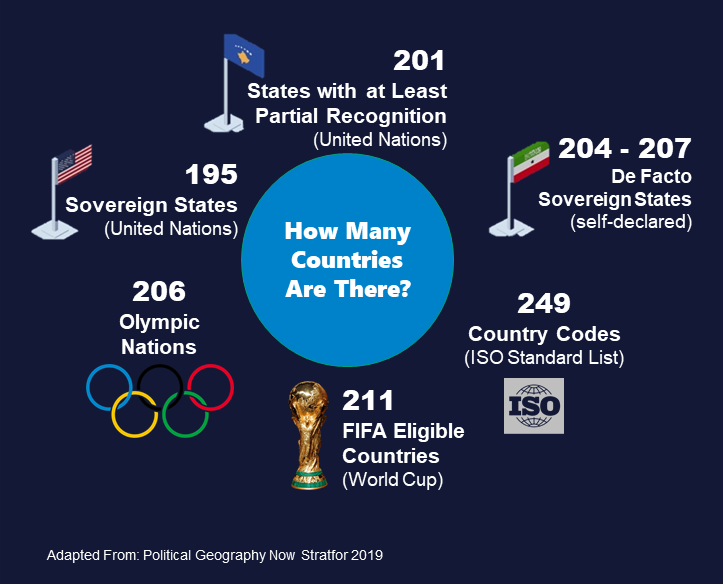A simple question such as “How many countries are there in the world?” would seemingly yield a simple answer. As the figure below illustrates, that’s not quite the case. The United Nations says there are only 195 sovereign states, but there are 204-207 self-declared countries, not to mention 211 FIFA countries eligible for the World Cup, and 206 Olympic Nations. So, what’s the “right” answer? It all depends on who you ask and the definition they have.

Searching for the Truth
As more companies are leveraging data, they’re realizing the “right” answer, or a single version of the “truth,” isn’t always straightforward. This has prompted IT departments to call for more data governance and control so that when employees ask the same question, they’re able to access reliable, accurate data and analytics to get the same answer.
The concept sounds good in principle: master your data in one place, and be assured that the same question yields the same answer. Unfortunately, the theory doesn’t hold up in most organizations, and even worse, the processes put in place to create this environment can end up more damaging than having different answers to the same question.
The Hard Truth About Getting to the Truth
First, let’s talk about why there are frequently different numbers in systems that contain different answers to similar questions.
Let’s say you’re a manufacturing company that makes appliances. You want to know the total cost of all the parts that were used to make appliances for the last year and you send two analysts off to obtain the answer. One determines that the parts used to make the appliances totaled $100M and takes last year to mean all the parts ordered from January through January.
The second analyst takes that same question and uses two slightly different definitions. First, the total number of parts this analyst uses includes not only the parts used to make the appliances when they were new, but also includes the parts used to service appliances that were already in the field. In addition, this analyst defines what parts to include as the parts that were paid for during this time period, instead of what was ordered during this time period.
So, Who’s Right?
Which of these definitions is the right way to think about the question? The reality is that it could be both of them, only one of them, or neither. It all depends on what business problem you’re working to solve.
Each system in a company keeps slightly different versions of the numbers that are suited for what those systems work to solve. Purchasing is focused on the orders and accounts payable cares about the payments. Other departments require other nuanced definitions to serve the requirements of the problems they often work to solve. In the end, there are many answers to “What is the total cost of all the parts we used to make appliances last year?”
Truth Lies in the Eyes of the Beholder
Who can determine which version of the truth is the right one? In this example, I think you can see that truth is likely in the eyes of the beholder. If the question is being asked by accounting, they, and likely only they, can determine which version will meet their needs. A separate group trying to control the answer they obtain is likely not helpful.
It becomes clear that the truth also depends on what question is really being asked. When you ask for the total cost of all parts used to make appliances last year, analysts can fairly ask in return, “What kind of costs? Would you like to include tax? How about shipping costs?”
How to Get Everyone on the Same Page
While some may argue that a single version of the truth is illusory, companies still need to make sure various aspects of data and analytics are in alignment between teams. Explore our three tips for helping your organization get to its single version of the truth.
- Democratize data responsibly: Share data throughout the company by creating a data lake for easy access. But do it responsibly with data governance. Companies need to ensure that data is not only easily accessible to all employees, but also accurate, reliable, secure, and audited. Getting to a single version of the truth starts with all teams having access to the same data. They’ll be able to discover exactly what they’re looking for under their specifications.
- Provide data training and upskilling: Create citizen data scientists by helping your employees learn the skills to turn data into decisions. Give them the appropriate training so that they can comfortably and confidently work with data, ask precise questions, recognize the nuances in finding answers, and discover their own insights.
- Enable sharing and reusing: Make sure that queries, analytical models, background documentation, dashboards, reports, and insights are shared. This helps create one version of the truth among colleagues. It also creates efficiencies. For example, rather than creating a new query to calculate “total sales,” a simple search would allow the user to discover relevant queries, along with documentation, written by other teams. The user should have transparency on what data is being pulled and where it’s being pulled from so they can leverage the company’s collective knowledge.
If your organization has embarked on a digital transformation journey, we would love to hear about your successes and failures obtaining the “truth,” and how you are providing enablement, or even better, how you have been enabled by the efforts of your data science function.